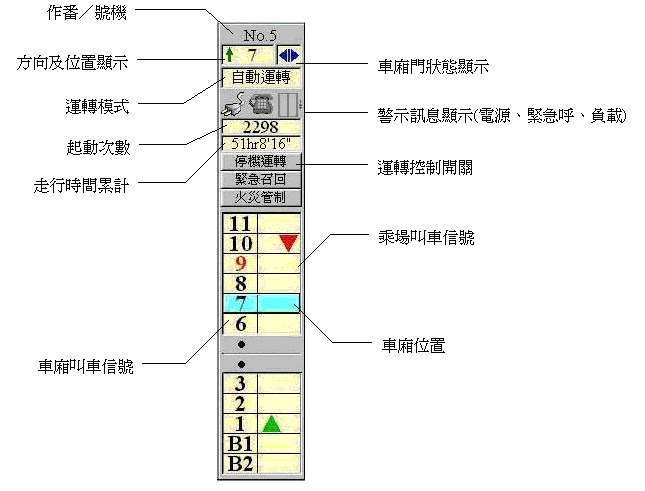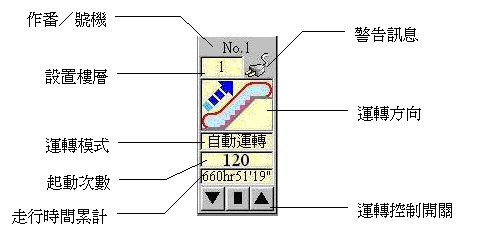-




 E PASS Intelligent System智能 E PASS
E PASS Intelligent System智能 E PASS
CRT Monitoring


Characterization
The Purpose of the Central Control System
Purpose
From early times until now, man continually invented and sought progress, expanding the range of people’s lives and reducing distances. The progress of transportation, from original man through the industrial revolution, utilized animal powered transportation. After the industrial revolution steam power and trains were invented, and the end of the 19th century saw the advent of fossil fuel powered combustion engines, bringing man into the automobile age. Today, there are many types of transportation tools and each have specific uses.
In modern cities, cars and motorcycles are common transportation, and subways are playing an increasingly important role. Aside from this, an important tool that most people don’t thing of is the elevator. Because of the population density of modern cities, land area is difficult to obtain. Buildings have gradually been built higher. In high rise buildings, elevators are a necessary transportation tool. On the other hand, economic flourishing and the increase of the standard of living have made elevators a standard part of apartments and buildings.
Elevators are a transportation tool for carrying people, and must carry heavy safety protection. With regularly scheduled repairs and maintenance, elevator safety is trustworthy. However, there are many outside influences that may affect elevator operations, such as electrical outages, fires, earthquakes, etc., which may lead to inconvenience or even people shut within an elevator. Even though buildings have security guards who can immediately respond, the number of floors in some buildings is high, and determining the position of an elevator may be difficult because of large square meter areas, so security guards not be able to adequately respond. Sending elevator information for the entire building, showing up to date elevator operational information, is a necessary help for security in managing large buildings. Additionally, having elevator information is helpful in determining flow patterns.
Traditional elevator central control systems utilize message cables to send messages to the central control room, and then the messages are displayed using lights on the central control panel indicators. If elevators operations are to be controlled, it also must be done through the central control board switches using message cables connected to the elevator machine room, finally accomplishing the control goal.
Traditional elevator central control systems’ greatest benefit is operational simplicity, but it has inherent shortcomings. Because the elevator contact points are numerous, the number of message cables are also numerous. Using light indicators is a less trustworthy method, as faulty connections or light problems may not indicate problems. Also, traditional elevator central control systems are only able to perform display functions, they are not able to save messages making follow-up impossible.
As personal computer software and hardware capabilities constantly increase and operational usage becomes simpler, personal computers can be used as the heart of elevator central control systems. Indicators utilize cathode ray tube monitors, different from traditional elevator central control systems. We call this the CRT elevator central control system.
The CRT elevator central control system uses RS-485 communication conventions, forming the link between the CRT elevator central control system and the elevator. It requires only two buds of communications cable, drastically reducing the needed amount of cable. And as contact points are reduced, the reliability is increased. The CRT elevator central control system can record a large volume of information and prepare for future follow-up. To work appropriately domestically, Chinese and picture icons are used in displays, enhancing the usability of the CRT elevator central control system under all circumstances.
CRT Central Control System Features
The CRT 2K Central Control System automatically begins the following tasks at the successful completion of computer startup:
Monitoring
Monitoring─the control system shows the following, according to the messages sent back by the elevator
(a) elevator description and number
(b) elevator cage position
(c) operational direction
(d) elevator cage door situation
(e) operational mode
(f) elevator cage calls
(g) passenger area calls for ascending elevators
(h) passenger area calls for descending elevators
Control
Control─the control system sends control messages to the elevator control panel based on user needs
(a) stop operation
(b) no stops
Emergency Call
Emergency Call─the control system, based on messages from the elevator, can determine abnormal operations by the following methods
(a) displays:displays an abnormal operation report, alerting the security personnel
(b) sounds:through the sound card and the speakers, an “abnormal operation” message is sent, alerting security personnel
(c) printing:a message relative to the abnormal operation is printed
(d) saved files:the elevator’s abnormal operation information is saved in the information vault, for later examination
Records
Records─the control system makes records based on the elevator messages
(a) elevator situation records:the control system, based on the elevator messages, saves the situational report when an abnormal operation occurs
(b) elevator control report:when the control system is used to control an elevator, the operations are recorded and saved
(c) control situation records:the control system operations and messages are recorded


Characterization
The Purpose of the Central Control System
From early times until now, man continually invented and sought progress, expanding the range of people’s lives and reducing distances. The progress of transportation, from original man through the industrial revolution, utilized animal powered transportation. After the industrial revolution steam power and trains were invented, and the end of the 19th century saw the advent of fossil fuel powered combustion engines, bringing man into the automobile age. Today, there are many types of transportation tools and each have specific uses.
In modern cities, cars and motorcycles are common transportation, and subways are playing an increasingly important role. Aside from this, an important tool that most people don’t thing of is the elevator. Because of the population density of modern cities, land area is difficult to obtain. Buildings have gradually been built higher. In high rise buildings, elevators are a necessary transportation tool. On the other hand, economic flourishing and the increase of the standard of living have made elevators a standard part of apartments and buildings.
Elevators are a transportation tool for carrying people, and must carry heavy safety protection. With regularly scheduled repairs and maintenance, elevator safety is trustworthy. However, there are many outside influences that may affect elevator operations, such as electrical outages, fires, earthquakes, etc., which may lead to inconvenience or even people shut within an elevator. Even though buildings have security guards who can immediately respond, the number of floors in some buildings is high, and determining the position of an elevator may be difficult because of large square meter areas, so security guards not be able to adequately respond. Sending elevator information for the entire building, showing up to date elevator operational information, is a necessary help for security in managing large buildings. Additionally, having elevator information is helpful in determining flow patterns.
Traditional elevator central control systems utilize message cables to send messages to the central control room, and then the messages are displayed using lights on the central control panel indicators. If elevators operations are to be controlled, it also must be done through the central control board switches using message cables connected to the elevator machine room, finally accomplishing the control goal.
Traditional elevator central control systems’ greatest benefit is operational simplicity, but it has inherent shortcomings. Because the elevator contact points are numerous, the number of message cables are also numerous. Using light indicators is a less trustworthy method, as faulty connections or light problems may not indicate problems. Also, traditional elevator central control systems are only able to perform display functions, they are not able to save messages making follow-up impossible.
As personal computer software and hardware capabilities constantly increase and operational usage becomes simpler, personal computers can be used as the heart of elevator central control systems. Indicators utilize cathode ray tube monitors, different from traditional elevator central control systems. We call this the CRT elevator central control system.
The CRT elevator central control system uses RS-485 communication conventions, forming the link between the CRT elevator central control system and the elevator. It requires only two buds of communications cable, drastically reducing the needed amount of cable. And as contact points are reduced, the reliability is increased. The CRT elevator central control system can record a large volume of information and prepare for future follow-up. To work appropriately domestically, Chinese and picture icons are used in displays, enhancing the usability of the CRT elevator central control system under all circumstances.
CRT Central Control System Features
The CRT 2K Central Control System automatically begins the following tasks at the successful completion of computer startup:
Monitoring─the control system shows the following, according to the messages sent back by the elevator
(a) elevator description and number
(b) elevator cage position
(c) operational direction
(d) elevator cage door situation
(e) operational mode
(f) elevator cage calls
(g) passenger area calls for ascending elevators
(h) passenger area calls for descending elevators
Control─the control system sends control messages to the elevator control panel based on user needs
(a) stop operation
(b) no stops
Emergency Call─the control system, based on messages from the elevator, can determine abnormal operations by the following methods
(a) displays:displays an abnormal operation report, alerting the security personnel
(b) sounds:through the sound card and the speakers, an “abnormal operation” message is sent, alerting security personnel
(c) printing:a message relative to the abnormal operation is printed
(d) saved files:the elevator’s abnormal operation information is saved in the information vault, for later examination
Records─the control system makes records based on the elevator messages
(a) elevator situation records:the control system, based on the elevator messages, saves the situational report when an abnormal operation occurs
(b) elevator control report:when the control system is used to control an elevator, the operations are recorded and saved
(c) control situation records:the control system operations and messages are recorded
智能E PASS 123
E PASS Intelligent System


